Rudbeckia - a wonderful flower that will please both beginner gardeners and experienced gardeners. Experienced growers like rudbeckia for its excellent ability to complement the floral arrangements at the site, making unusually bright colors to dull scenery. But novice growers will love the unpretentiousness of this flower. Of course, not do without the basic rules of care and planting, but in general, rudbeckia is not demanding to care for.
This amazing flower in its beauty was brought to Europe by migrants from North America. It was there for the first time he was noticed. The collapse of Rudbecia was fascinated, immigrants originally called her black-eyed suzanny. In Europe, this flower began to be actively grown. For its modern name, Rudbeckiya a long-term owner is obliged to Karl Linneu. He called this plant in honor of his friend Olaf Rudbeck, who was Botany. Linney was so admired by this flower, which suggested him a great future - it will exist until there is peace and nature in it. By the way, one of the American states - Maryland, considers Rudbecki's hair with his symbol. If you correctly pick up the ground for Rudbecia, then it will certainly please you with your blossom almost to the most frosts. In this article, consider the basic rules of landing, care and growing Rudbecia many years, and also learn about the methods of its reproduction.
Rudbecky long-term in the photo
Already only in one photo can be seen as a colorful flower. In its appearance, it is very similar to the chamomile. But it was precisely a bright yellow color allocates Rudbekia among other garden colors. Thanks to his juicy color, Rudbecky many years is often called the "golden sun", "golden ball", "golden tower", "sunny hat". Narrow, and sometimes wide Rudbequica petals modestly bent down, opening a gorgeous velvet middle to universal manufacture. Do not think that this flower is bored in appearance, because He has color only one yellow color. You can meet Rudbecia of a wide variety of shades and halftone yellow: gently lemon yellow, golden-yellow, copper-yellow, orange-yellow, brown-yellow. This Sunny will really make bright paints and a sunny mood to your garden.
Types and varieties of Rudbecia Multi-Year
Rudbeckia belongs to the Astrov family and can be grown not only as a perennial, but also annual. Stem in Rudbecia Straight and high, ending with infringing with a diameter of up to 15 cm.
1. Rudbeckia dissected. This is one of the most unpretentious varieties of Rudbecia, which, moreover, is considered the highest, because Can reach 2 meters in height. Rhizome in such Rudbecia horizontal and sufficiently impressive sizes.
- grade "Golden Ball" (Goldball). One of the most common and unpretentious varieties. If you need to decorate some kind of unsightly place on the plot, hide not very aesthetic buildings, then feel free to choose this variety. The rhizome of this Rudbecia is growing at high speed. Try not to plant other plants around it. In order to prevent further growing rhizomes, you can drive Slate to Earth. The inflorescence "Golden Bowl" terry or semi-world. Flowering can last to the most frosts;
- Grade Goldkwelle. This variety is low, reaches 80 cm in height. It looks perfectly in combination with other bright plants in the flower beds. Flowers from August to September.
2. Rudbeckia brilliant. This Rudbekia is sometimes called radiant from behind the puff of flowers. The plant is considered short, up to 80 cm in height. It is very branched and blooms for 40-45 days.
- vanabilis grade.This variety has inflorescences up to 9 cm in diameter. The leaves are narrow and solid. Blossom begins in August and continues until September;
- sullivantii grade.Rudbecia of this variety poorly tolerate dampness and are a bit demanding to the soil. The plant, though he loves the hot sun, but not very - dry ground. This perennial will have to renew in 3-4 years of growth. Propagated by young rosettes on the roots.
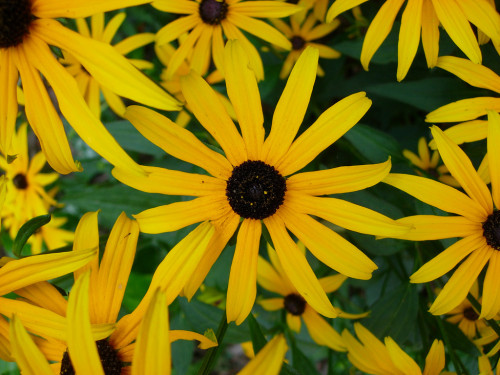
3. Rudbeckiy Masha. Such Rudbekia can be grown both in an annual plant and a bilateer. This species received this species thanks to a strongly sowed stalk. Rudbeckia Masproy can grow high to 1 meter. Remarkably suitable for cutting bouquets, because It has long flowerons. Flowers love this view for its abundant and long bloom.
- goldStrum. The lowest variety of Rudbecia with hard hairs across the stalk. Leaves have a dark green color;
- gloriosa Desy. The variety can be grown as an annual and two-man. It reaches a height of 120 cm. Rudbecks of this variety looks like a highly branching bush, which has huge flowers with a diameter of up to 16 cm. Fruit and can multiply seeds.
- maine Fride. One of the most spectacular varieties of Rudbecia. Dark orange flowers with a black center abundantly cover the entire bush and look in the aggregate as a huge color spot on the plot. Ideal for decor.
4. Rudbeckia glossy. Tall kind of Rudbecki, which can grow in your area up to 2 meters in height. Its title is obliged to egg-shaped and brilliant flowers 12 cm in diameter.
- goldschirm.. Highly branched bush up to 2.5 m in height. Grown in Rabatkov from the south. Ideal for cutting;
- herbstzonne. Another grade of Rudbecia, which is characterized by high growth - 2 m in height. Beautiful yellow flowers with a diameter of 12 cm have a slightly bent down petals.
5. Rudbeckia purple or echinacea purple. Rudbeckia purple is the most controversial view of all Rudbeck. Currently, it exists as a completely different appearance - Echinacea Purple. Initially, Echinacea was attributed to Rudbeckiyiam Karl Linneem. But later, one German botanist revealed a number of differences between these flowers and taken Rudbecki purple to Echinacea purple. Since then, the flower bears just such a name. The appearance of Echinacea is quite bright and notable. In addition to bright purple color, a huge "bump" in the center of the flower rushes into the eyes. Because of this feature of the building, Echinacea is called in America "Purple Flower-Bryer". This is a small history of the emergence of two, in something similar flowers - Rudbecia of purple and echinacea purple.
6. Rudbeckia two-color. One of those types of Rudbecia, which proves that this flower can be grown in "not boring" yellow color. It can combine bright yellow, dark orange and black and purple color. It has a characteristic strongly convex color blossom.
Grow Rudbekia at home
Landing many years of Rudbecki seeds
All Rudbequica varieties, except for Makhrova Rudbecia, are able to multiply generally. Many years of Rudbecky successfully grown by the method of sowing seeds directly into the open ground.
- To do this, choose the right time to land and landing. Since Rudbeckia is not at all demanding to the soil, then any echultured and fertile soil will fit. This flower of sunny color can grow both in the shade and in a sunny place. However, if you select a solar section for Rudbecki, remember that you will have to water it more often and monitor the soil moisture.
- The best time for sowing seed will be the middle or end of June.
- Prepare rows for seeds and put them shallow into the ground at a distance of 15 cm apart.
- After that, sprinkle their ground slightly and spray with water.
By the fall, you will have small outlets, which next year will turn into elegant and branchy bushes. But the simplest and not troublesome way of reproduction of Rudbecia many years of seeds is her self-resin. All you need to do is to break up the growing outlet, and everything else will make nature for you.
Landing many years of Rudbecki ever
A seaside method of reproduction also does not require complex actions.
- Press the seeds in the seedlings in the same way, if you sow them into open ground. It is best to do at the end of March.
- Sleep slide seeds, spray with water and cover with a film.
- The room temperature where the boxes will be stored, there must be 21-22 degrees. Regularly ventilate the seedlings and remove the condensate.
- Shoots should appear after 1-2 weeks.
- After two pairs of leaves on seedlings appear, they need to be counted for more comfortable growth.
- Gradually, order seedlings - take it out on a balcony or a terrace for a couple of hours.
- When the threat of night frosts passes, and this is usually the end of May - the beginning of June, then you can plant seedlings in open ground.
- Earth before landing can be fertilized by a compost.
- Squake Rudbekia at a distance of 30-40 cm from each other.
If spring is given a protracted, then Rudbeckia can take up longer. If the flower has not yet become, but the frosts returned, it is better to hide Rudbecki. But when she finally arrives, then no low temperatures will be scary.
Rudbecia reproduction with many years of the division of the bush
Perennial Rudbeckia is able to multiply well and the fission of the root. It will be not only a method of breeding, but also a wellness procedure for a flower. Approximately 1 time in 3-5 years it is necessary to divide bushes. It is necessary to do this either in the spring when shoots begin to appear, or in the fall, when the bush fled. Performing such a procedure, you save the flower decorativeness and do not give too much to grow root, which grows too fast.
Caring for Rudbecki on the site
Uncomplicated RUDBEY Care You can describe the following rules:
- Regular watering. If your plant grows in a sunny place, then watering it will need more frequent. Watering best in the morning or evening.
- Lucm soil after irrigation. This procedure is done as needed.
- Creating support for high plants.
- Removal of flashing inflorescences.
- Deleting weeds.
- Rudbecki Transplant Perennial. It is performed 1 time in 3-5 years, depending on the size and branches of the bush. The root system of this plant develops very rapidly, and in order not to clog the site, it is recommended to transplant it to a new place. To do this, it is necessary to dig a bush and divide it into several parts. After that, disembark separated parts into new places at a distance of each other.
These simple rules of care will allow you to grow chic Rudbecki bushes at home. It is safe to say that all these manipulations can fulfill a person who has never worked in the cultivation of garden flowers, i.e. Beginner gardener.
Up. Rudbecia
Up. Rudbecia is carried out by the following stages:
- Soil fertilizer with compost. This type of feeding is carried out with all types of landing of Rudbecki into the ground: repentable, through seeds, the division of the bush.
- Feeding at the beginning of the season. Prepare a solution of 1 tbsp. Nitroposki, 1 tbsp. Potassium sulfate, 1 tbsp. Agrikolay-7 and 10 liters of water. Calculate the volume of such a solution on the basis of 3 l per 1 sq.m.
- Next feeding in 2 weeks. It is carried out with a similar solution.
Rudbeckia after flowering and winter
So, your beautiful Kuste Rudbeci pleased you with bright blooming all summer and autumn, and here he fled. What to do next?
- If you do not plan to collect seeds, then you can simply remove the bulk inflorescences. But you can collect them. Then you will have your own planting material.
- Put the gloves and carefully collect dry seeds. They will need to dry carefully.
- Store seeds preferably in paper bags or ventilated fabric bags in a cool room.
- Remember that even if you decide not to collect seeds, they can disseminate the wind and sow themselves.
- Since Rudbeckia is a perennial, it can carry the winter. But for this, after the end of the flowering period, cut the entire above-ground part of the plant. Cover Rudbekia by a layer of humus in 5-7 cm, sweet snap or dry grass. With the arrival of winter, the best shelter will serve snow.
We protect Rudbecki from pests and treat diseases
Rudbeckia Perennial - a tempting flower for inexperienced gardeners is also a factor that it is practically not subjected to pests, and the disease amazed Rudbecki extremely rarely. However, to fully imagine a picture of the care and cultivation of Rudbecki in his area, you need to get acquainted with information about diseases and pests in order to recognize the symptoms on time.
Most diseases are amenable to treat, like pests, from which it is possible to successfully save the plant if the treatment time is in a timely manner.
- Sometimes in Rudbecia many years can appear leaf nematodes. In addition to the fact that they slowly rub the plant, so they significantly spoil the decorative value of this plant. Nematodes are small worms that are breeding in the ground or in the plant itself. Due to the fact that the worms microscopic, they are detected when the plant has already been greatly struck. Nematodes oppress the growth of Rudbecia, settled at all of its parts.
Symptomsflower lesions with sheet nematodes are brown, light yellow or purple spots on the leaves. Gradually, the leaves are drying, thinning and disappear. Unfortunately, if the leaf nematodes struck your Rudbekia, then it will have to remove it. But it is possible to carry out prevention: not to allow excessive irrigation, carefully examine the seedlings or a bush before planting the presence of these parasites.
- Puffy dew - This is a fungal disease that can destroy the plant, if it is not in time noticed. It is manifested by the appearance of white raid, similar to dust, on the leaves of the plant. This hat can be erased by a finger, but then it will appear even more and covers even more parts of the plant. The leaves become sluggish, the new leaves grow as ugly and irregular shape. The fungus gradually "eats" the whole plant. There are special preparations that need to spray the plant. Spraying should be abundant, wetting all parts of the plant. One of the good options is a complete "bathing" of a bush in solution. It is also necessary to replace the upper layer of the soil near Rudbecia, because There can be shared whole colonies of fungi.
- Rudbeckia Perennial can sometimes get sick and so fungal disease as rust. This disease can be easily recognized. On the leaves appear bubbles of yellow, orange or rusty. Then these bubbles burst and from there rusty powder hurts - spores fungus. Plant treatment by fungicides is the only method of treatment. Also, do not forget about the prevention: the right agrotechnical actions, regular weeding.
As you can see, the care of Rudbecky many years is not at all complicated and to grow this solar flower at home is quite a time-consuming process. Try to grow this plant as an independent "soloist" on your flowerbed, and in combination with other groups of plants. Successes in horticultural business!

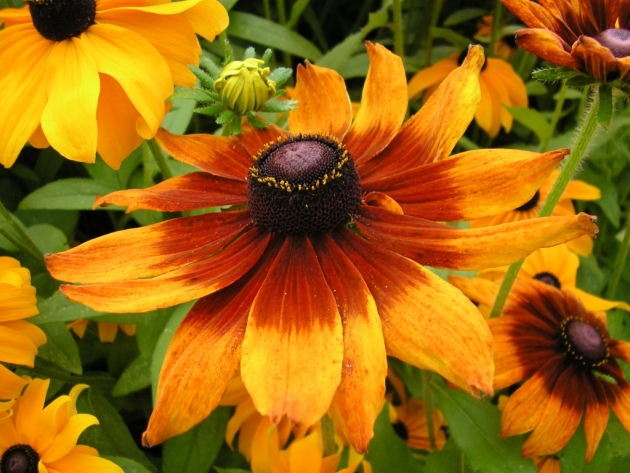
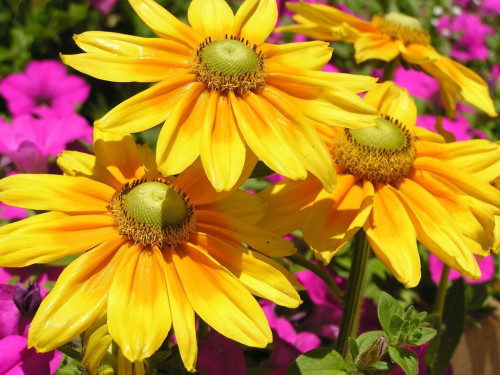
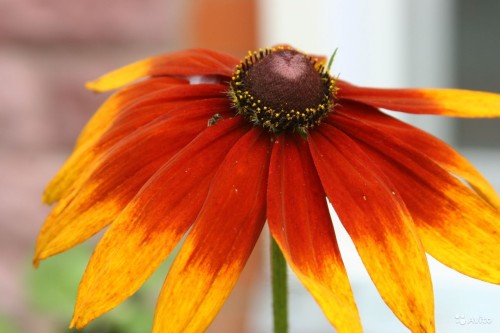
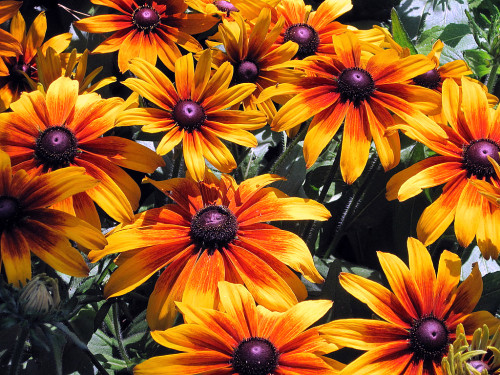
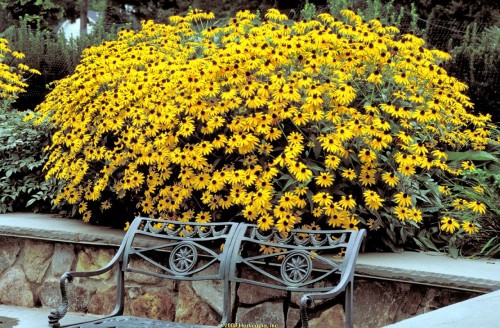
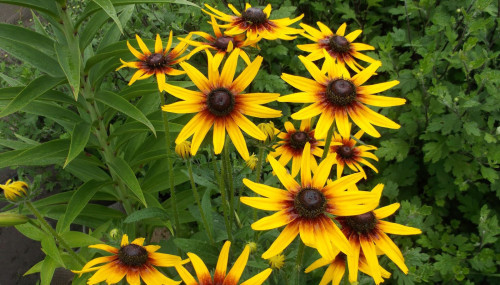
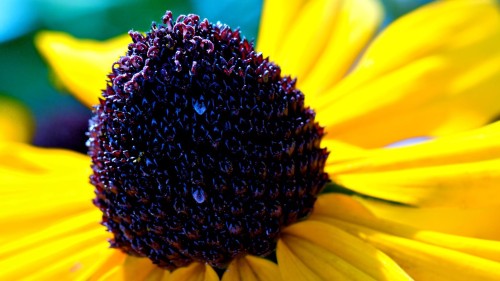
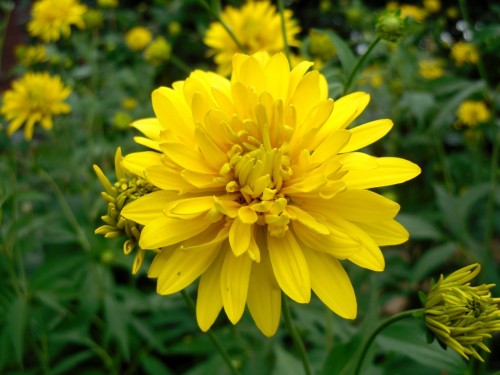
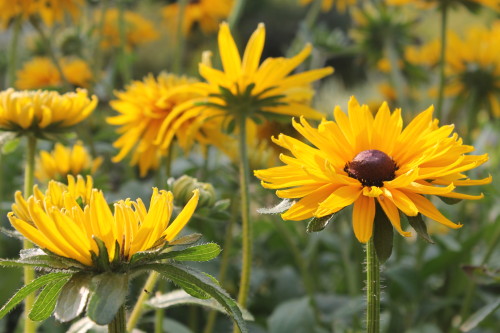

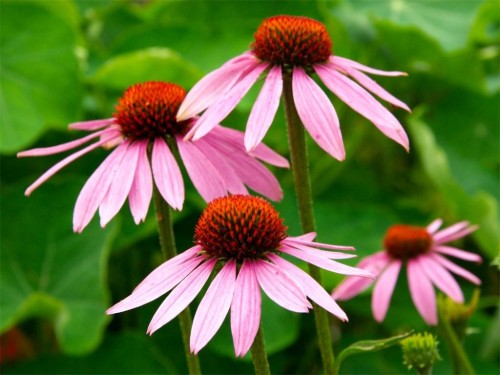
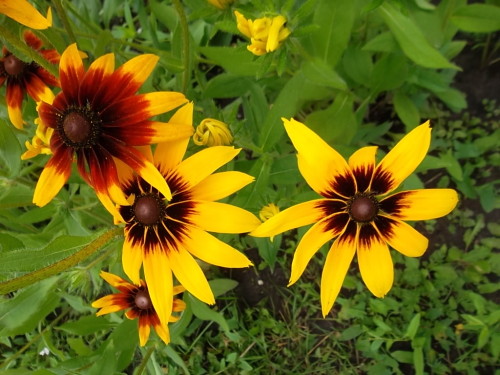
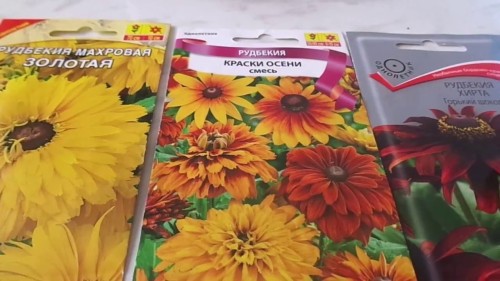
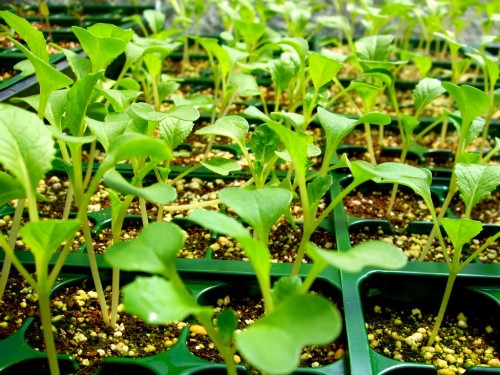
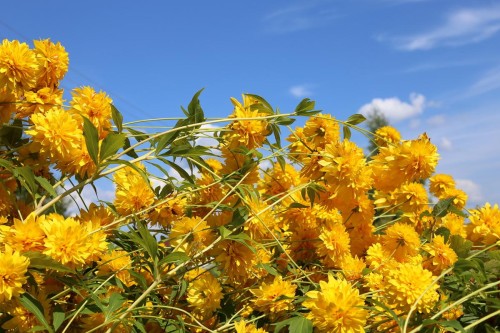
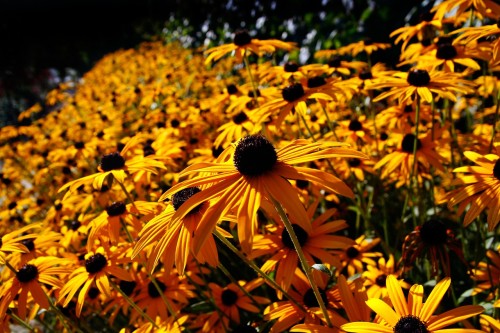












 Start a discussion ...
Start a discussion ...